In spring, as students are busy with standardized testing and end-of-school projects, it’s especially important to make time for recreational independent reading, which increases motivation, generates a sense of agency, and sets the tone for summer reading, among other benefits. Here are some recently published books that are engaging, informative, and—above all—fun to read.
Ages 4–8
A Bear Sat on My Porch Today. Jane Yolen. Ill. Rilla Alexander. 2018. Chronicle.
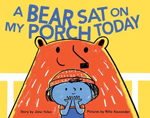 In this cumulative rhyming tale, a young boy tries to chase away a brown bear, gray squirrel, spraying skunk, playful possum (with her passel of eight babies), clever raccoon, friendly moose, and loudmouthed blue jay when they invite themselves, one at a time, to hang out on his porch, but reluctantly agrees to let them remain. “Okay. Okay! You can stay.” When the porch collapses under their collective weight, the creatures work together to rebuild it while bonding as friends. Pencil and digital collage illustrations and a gatefold picturing the uninvited guests gathered on the porch add to the fun of reading this story about hospitality.
In this cumulative rhyming tale, a young boy tries to chase away a brown bear, gray squirrel, spraying skunk, playful possum (with her passel of eight babies), clever raccoon, friendly moose, and loudmouthed blue jay when they invite themselves, one at a time, to hang out on his porch, but reluctantly agrees to let them remain. “Okay. Okay! You can stay.” When the porch collapses under their collective weight, the creatures work together to rebuild it while bonding as friends. Pencil and digital collage illustrations and a gatefold picturing the uninvited guests gathered on the porch add to the fun of reading this story about hospitality.
—NB
I Got a Chicken for My Birthday. Laura Gehl. Ill. Sarah Horne. 2018. Carolrhoda/Lerner.
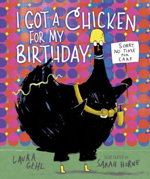 Having told her abuela that she wants amusement park tickets for her birthday, a girl is disappointed with the gift she receives: a chicken. However, it’s not an ordinary chicken. Bright, detailed, mixed-media illustrations feature the plump black chicken, who communicates by holding up signs and who has no time for laying eggs. What the chicken has is a plan and a long shopping list (which unfurls across a double spread). Enlisting the girl’s pet dog, cat, and hamster, as well as her own bird friends, the chicken creates a private amusement park. After a fun-filled day, the girl declares, “Next year, I’m asking Abuela Lola for a trip to the moon!”
Having told her abuela that she wants amusement park tickets for her birthday, a girl is disappointed with the gift she receives: a chicken. However, it’s not an ordinary chicken. Bright, detailed, mixed-media illustrations feature the plump black chicken, who communicates by holding up signs and who has no time for laying eggs. What the chicken has is a plan and a long shopping list (which unfurls across a double spread). Enlisting the girl’s pet dog, cat, and hamster, as well as her own bird friends, the chicken creates a private amusement park. After a fun-filled day, the girl declares, “Next year, I’m asking Abuela Lola for a trip to the moon!”
—CA
Kalinka and Grakkle. Julie Paschkis. 2018. Peachtree.
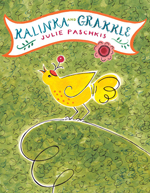 Neighbors Kalinka and Grakkle couldn’t be more different. Kalinka, a small yellow bird, is a helpful neat freak, and Grakkle, a burly and bad-tempered beast, is happiest snoozing in his favorite chair while soaking his feet in a bucket of pickle juice. When Kalinka decides to tidy Grakkle’s messy house without permission, her efforts create even more chaos as she stuffs his dirty socks in the woodstove, crumbles his cookies, pokes pencils into a box of spaghetti, and slides mail into the toaster. After frustrated Grakkle throws a tantrum, Kalinka almost perishes in the pickle juice, but he saves her just in time. Exhausted, they take a long afternoon nap together. Colorful, swirly, ink-and-gouache illustrations complement this silly story of unexpected friendship.
Neighbors Kalinka and Grakkle couldn’t be more different. Kalinka, a small yellow bird, is a helpful neat freak, and Grakkle, a burly and bad-tempered beast, is happiest snoozing in his favorite chair while soaking his feet in a bucket of pickle juice. When Kalinka decides to tidy Grakkle’s messy house without permission, her efforts create even more chaos as she stuffs his dirty socks in the woodstove, crumbles his cookies, pokes pencils into a box of spaghetti, and slides mail into the toaster. After frustrated Grakkle throws a tantrum, Kalinka almost perishes in the pickle juice, but he saves her just in time. Exhausted, they take a long afternoon nap together. Colorful, swirly, ink-and-gouache illustrations complement this silly story of unexpected friendship.
—NB
King Flashypants and the Creature From Crong (King Flashypants #2). Adam Riley. 2018. Henry Holt.
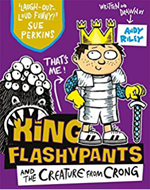 When Baxter the hermit from the Wilderness of Crong tells the people of Edwinland that he saw the Voolith, thought to be dead, eating his goats and cow, 9-year-old King Edwin Flashypants vows to defeat the monster. Evil Emperor Nurbison has plans of his own, however, and sends King Edwin on a wild goose chase into a volcano with fire toads. In the meantime, Nurbison tricks the Voolith into becoming his slave, so that he can take over Edwin’s kingdom while he’s gone, but that plan backfires when the Voolith eats him instead. Upon Edwin’s return, the Voolith gobbles him up (covered in pumpkin slush). Luckily, the Voolith burps him back up, and Edwin discovers that every hero needs a crew to defeat a monster. This rousing romp, complemented by expressive black-and-white cartoon illustrations, ends with a teaser for the third book in the series and a short comic strip.
When Baxter the hermit from the Wilderness of Crong tells the people of Edwinland that he saw the Voolith, thought to be dead, eating his goats and cow, 9-year-old King Edwin Flashypants vows to defeat the monster. Evil Emperor Nurbison has plans of his own, however, and sends King Edwin on a wild goose chase into a volcano with fire toads. In the meantime, Nurbison tricks the Voolith into becoming his slave, so that he can take over Edwin’s kingdom while he’s gone, but that plan backfires when the Voolith eats him instead. Upon Edwin’s return, the Voolith gobbles him up (covered in pumpkin slush). Luckily, the Voolith burps him back up, and Edwin discovers that every hero needs a crew to defeat a monster. This rousing romp, complemented by expressive black-and-white cartoon illustrations, ends with a teaser for the third book in the series and a short comic strip.
—NB
Terrific Tongues! Maria Gianferrari. Ill. Jia Liu. 2018. Boyds Mills/Highlights.
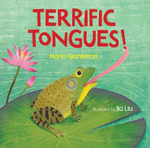 After instructing readers to “STICK OUT YOUR TONGUE!”, a cute little monkey proceeds to introduce 12 types of tongues that belong to different animals in what becomes a guessing game. For example, an illustration of the monkey with a long straw sipping up water from a pond is paired with the text “If you had a tongue like a straw you might be a . . .” A turn of the page reveals the answer: “MOTH!” along with a brief paragraph providing information on the structure and function of the Darwin’s hawkmoth’s tongue. Back matter includes a “More About These Terrific Tongues” section and a list of eight more terrific tongues.
After instructing readers to “STICK OUT YOUR TONGUE!”, a cute little monkey proceeds to introduce 12 types of tongues that belong to different animals in what becomes a guessing game. For example, an illustration of the monkey with a long straw sipping up water from a pond is paired with the text “If you had a tongue like a straw you might be a . . .” A turn of the page reveals the answer: “MOTH!” along with a brief paragraph providing information on the structure and function of the Darwin’s hawkmoth’s tongue. Back matter includes a “More About These Terrific Tongues” section and a list of eight more terrific tongues.
—CA
Ages 9–11
Itch!: Everything You Didn’t Want to Know About What Makes You Scratch. Anita Sanchez. Ill. Gilbert Ford. 2018. Houghton Mifflin.
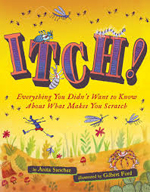 Those curious about the itch–scratch cycle will find this accessible and humorous book engrossing. After an introductory chapter about the anatomy of skin, “a bag with you inside,” seven chapters cover some of the animals and plants that commonly make humans itch, including lice, fleas, plants (such as poison ivy, prickly pears, and burrs), mosquitos, tarantulas, fungi, and bedbugs. The final chapter explores the question “Is there anything good about itching?” The inviting format also features historical anecdotes, insets with tips on avoiding and soothing itches, and illustrations. Back matter includes an author’s note, a glossary, a bibliography of books and websites, and an index.
Those curious about the itch–scratch cycle will find this accessible and humorous book engrossing. After an introductory chapter about the anatomy of skin, “a bag with you inside,” seven chapters cover some of the animals and plants that commonly make humans itch, including lice, fleas, plants (such as poison ivy, prickly pears, and burrs), mosquitos, tarantulas, fungi, and bedbugs. The final chapter explores the question “Is there anything good about itching?” The inviting format also features historical anecdotes, insets with tips on avoiding and soothing itches, and illustrations. Back matter includes an author’s note, a glossary, a bibliography of books and websites, and an index.
—CA
Spy Toys (Spy Toys #1). Mark Powers. Ill. Tim Wesson. 2018. Bloomsbury.
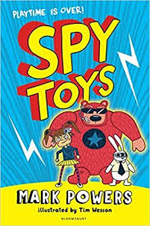 After Auntie Roz (an employee of the Department of Secret Affairs) rounds up Dan (a Snugliffic Cuddlestar Bear strong enough to crush a car in a hug), Arabella (a Loadsasmiles Sunshine rag doll with nasty attitude), and Flax (a rogue custom-made police robot rabbit) to work for her, she explains that their weaknesses (malfunctioning chips) make them natural spies. Their first job of protecting Sam Spinks, a senator’s son, from being kidnapped by Rusty Flumptrunk (the half-human, half-elephant crime boss) goes awry when the Spy Toys are on a ski trip with Sam, and Flumptrunk swoops the boy away. After the Spy Toys race to rescue, Sam against the ticking of the giant mayonnaise bomb strapped to his back, Dan is left with a life-changing decision. Black-and-white cartoon illustrations add to the humor of this action-packed first book in the Spy Toys series.
After Auntie Roz (an employee of the Department of Secret Affairs) rounds up Dan (a Snugliffic Cuddlestar Bear strong enough to crush a car in a hug), Arabella (a Loadsasmiles Sunshine rag doll with nasty attitude), and Flax (a rogue custom-made police robot rabbit) to work for her, she explains that their weaknesses (malfunctioning chips) make them natural spies. Their first job of protecting Sam Spinks, a senator’s son, from being kidnapped by Rusty Flumptrunk (the half-human, half-elephant crime boss) goes awry when the Spy Toys are on a ski trip with Sam, and Flumptrunk swoops the boy away. After the Spy Toys race to rescue, Sam against the ticking of the giant mayonnaise bomb strapped to his back, Dan is left with a life-changing decision. Black-and-white cartoon illustrations add to the humor of this action-packed first book in the Spy Toys series.
—NB
They Didn’t Teach This in Worm School! Simone Lia. 2018. Candlewick.
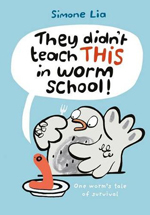 When Marcus, a homebody worm, encounters Laurence, a flying chicken (with a flamingo complex) who intends to eat him, he never expects that they will become fast friends. The two head to Lake Nakuru National Park in Kenya, with Marcus navigating from his perch atop Laurence’s soft feathers. Comic-style illustrations in gray, black, and red heighten the humor as the pair travel to places that aren’t what they think they are (mistaking an electrical tower for the Eiffel Tower, they think they’re in Paris), learn new skills (dancing and sleep-flying), and trick hungry new acquaintances (a mole, squirrel, and crow). Finally, they arrive at what they believe is Lake Nakuru (the flamingo pond in a zoo) only to discover they aren’t far from where they began and that dreams of adventure can come true—even if you discover you’re not a flamingo. Most important, Marcus learns that friends make you “try to be a better worm.”
When Marcus, a homebody worm, encounters Laurence, a flying chicken (with a flamingo complex) who intends to eat him, he never expects that they will become fast friends. The two head to Lake Nakuru National Park in Kenya, with Marcus navigating from his perch atop Laurence’s soft feathers. Comic-style illustrations in gray, black, and red heighten the humor as the pair travel to places that aren’t what they think they are (mistaking an electrical tower for the Eiffel Tower, they think they’re in Paris), learn new skills (dancing and sleep-flying), and trick hungry new acquaintances (a mole, squirrel, and crow). Finally, they arrive at what they believe is Lake Nakuru (the flamingo pond in a zoo) only to discover they aren’t far from where they began and that dreams of adventure can come true—even if you discover you’re not a flamingo. Most important, Marcus learns that friends make you “try to be a better worm.”
—NB
Ages 12–14
George Washington! (Action Presidents #1). Fred Van Lente. Ill. Ryan Dunlavey. 2018. HarperCollins.
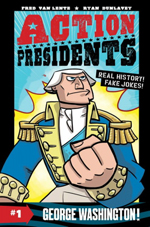 The first volume in this hilarious new graphic novel biography series, framed within a fictional story involving two kids and a talking turkey, balances humor and history to grab the interest of readers. Digital, black-and-white, caricatured illustrations keep the action going while a substantial amount of print content is contained within the panels. For instance, did you know that Washington didn’t have wooden teeth, but recycled real teeth (his own and those of others)? Back matter includes a timeline, a glossary, a “Stuff Named After Washington” section, and a bibliography. Abraham Lincoln! was simultaneously published in February 2018.
The first volume in this hilarious new graphic novel biography series, framed within a fictional story involving two kids and a talking turkey, balances humor and history to grab the interest of readers. Digital, black-and-white, caricatured illustrations keep the action going while a substantial amount of print content is contained within the panels. For instance, did you know that Washington didn’t have wooden teeth, but recycled real teeth (his own and those of others)? Back matter includes a timeline, a glossary, a “Stuff Named After Washington” section, and a bibliography. Abraham Lincoln! was simultaneously published in February 2018.
—NB
They Lost Their Heads!: What Happened to Washington’s Teeth, Einstein’s Brain, and Other Famous Body Parts. Carlyn Beccia. 2018. Bloomsbury.
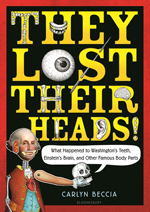 Carlyn Beccia presents curious readers with a most unusual book, focusing on what happened to various body parts (hair, teeth, head, brain, heart, or even a wart) of 17 historical figures after their deaths. Not for the faint of heart, these true stories (lightened by Beccia’s chatty and quirky style of writing and playful, black-and-white drawings) are fascinating as well as bizarre, creepy, and morbid. Additional sections on phrenology, embalming, cryogenics, cloning, organ donation, and forensic science are particularly interesting. Beccia includes an overabundance of footnotes. Some of these add information but most are flippant. Readers who feel compelled to read them may soon become annoyed by being pulled out of the text. Back matter includes notes on sources of quotations, a bibliography (organized by chapter), and an index.
Carlyn Beccia presents curious readers with a most unusual book, focusing on what happened to various body parts (hair, teeth, head, brain, heart, or even a wart) of 17 historical figures after their deaths. Not for the faint of heart, these true stories (lightened by Beccia’s chatty and quirky style of writing and playful, black-and-white drawings) are fascinating as well as bizarre, creepy, and morbid. Additional sections on phrenology, embalming, cryogenics, cloning, organ donation, and forensic science are particularly interesting. Beccia includes an overabundance of footnotes. Some of these add information but most are flippant. Readers who feel compelled to read them may soon become annoyed by being pulled out of the text. Back matter includes notes on sources of quotations, a bibliography (organized by chapter), and an index.
—CA
Ages 15+
Where’s Jane?: Find Jane Austen Hidden in Her Novels. Rebecca Smith. Ill. Katy Dockrill. 2018. Kane/Miller.
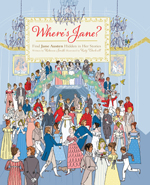 Where is Jane? She’s hidden in 10 scenes from six of her classic novels: Pride and Prejudice, Sense and Sensibility, Emma, Persuasion, Northanger Abbey, and Mansfield Park. Following a plot summary presented in a series of illustrated panels and a line-up of miniature portraits of characters to be looked for, the next double-spread page features a colorful, intricately detailed scene of elegant 19th-century homes, garden parties, picnics, and grand ballroom dances in which the readers can find the characters and also Jane Austen. By the end of the book, readers will be well acquainted with the characters and the settings of Austen’s novels. An answer key is included.
Where is Jane? She’s hidden in 10 scenes from six of her classic novels: Pride and Prejudice, Sense and Sensibility, Emma, Persuasion, Northanger Abbey, and Mansfield Park. Following a plot summary presented in a series of illustrated panels and a line-up of miniature portraits of characters to be looked for, the next double-spread page features a colorful, intricately detailed scene of elegant 19th-century homes, garden parties, picnics, and grand ballroom dances in which the readers can find the characters and also Jane Austen. By the end of the book, readers will be well acquainted with the characters and the settings of Austen’s novels. An answer key is included.
—CA
Nancy Brashear is Professor Emeritus of English from Azusa Pacific University, in Azusa, California. Carolyn Angus is former director of the George G. Stone Center for Children's Books, Claremont Graduate University, in Claremont, California.
These reviews are submitted by members of the International Literacy Association's Children's Literature and Reading Special Interest Group (CL/R SIG) and are published weekly on Literacy Daily.